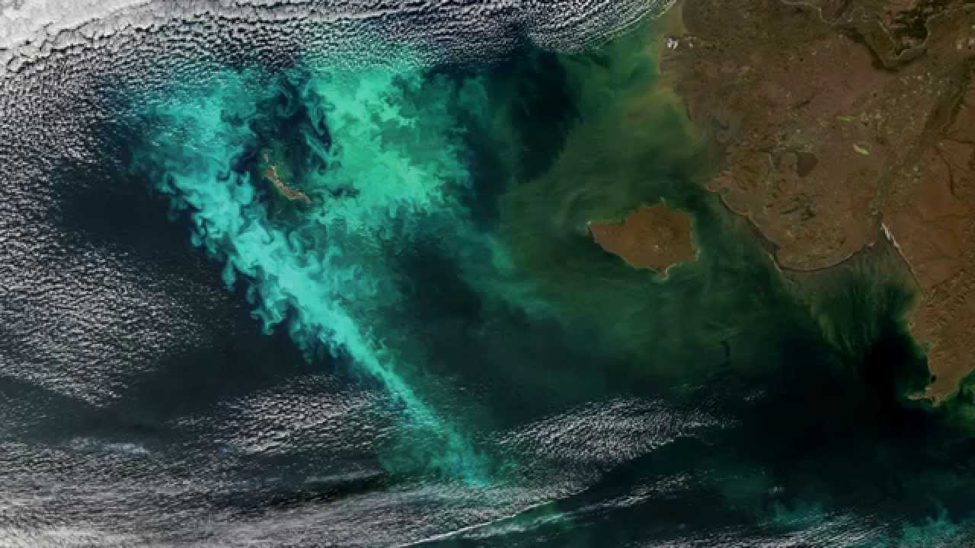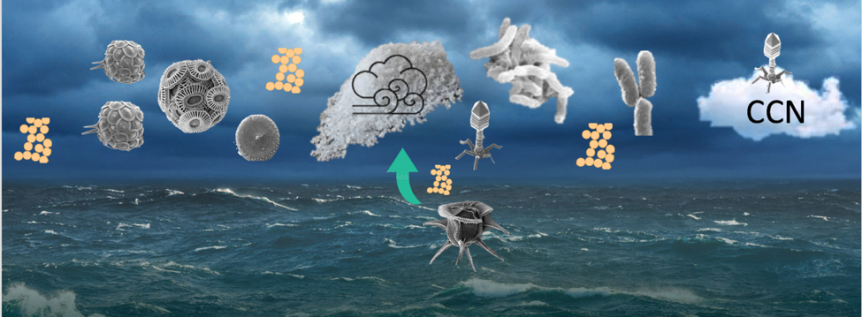Written By: Sarah Amiri
Walking in to the H-Lab at Scripps is like walking in to an enormous wooden spacecraft.
With a flume stretched across the floorplan filled with thousands of liters of coastal seawater. This mesocosm is surrounded by an almost unearthly network of sophisticated analytical machines specialized in better understanding atmospheric chemistry as it relates to air-sea exchange. Or more simply, how the ocean interacts with the air to influence atmospheric processes.
I’m climbing up the stairs to get a synoptic view of the scene. It’s chaotic, loud, buzzing and electric.
On the left, I see the flume’s paddle making the iconic sinusoidal wave pattern across the suite of experiments I pass by each morning, then my eyes scan the artificial beach used to break the waves to make sea spray. The seeds for aerosols and cloud condensation nuclei.

It turns out that the transport of sea spray is significant for the exchange between the sea and the atmosphere and the organic material it ejects. As someone who is pursuing experiments with research questions centered on chemical oceanography, I often think of biological material being exported down to depth or laterally advected across the coastal and global ocean. With all the mesoscale processes that this includes.
However, I now think of the ocean more like our P.I. Dr. Kimberly Prather does: With an allegorical arrow pointing up out of the waves and in to the clouds. Signatures of the sea up there, volatile and roaming.

I walk back down the stairs and head towards the right panel of the flume where our team is running samples on a benzene cluster cation chemical ionization time of flight mass spectrometer that will look at gases in the seawater using a cryo purge and trap.
We lovingly call this mass spec, Clifford. It has its own good luck candle with instructions to keep it alive in the event of an apocalypse. Of course it does.
Our team is primarily interested in the types of trace volatile gasses that phytoplankton and bacterioplankton can produce and get released into the lower atmosphere (after a series of production and consumption pathways).
This can have larger effects on increasing albedo that can lead to a climate cooling, or to the release of deleterious trace gasses that can lead to ozone depletion in the stratosphere. To better understand how these nuanced processes works, I now look under the green saltwater line of the wave flume where the marine biota lives.
Phytoplankton are sometimes referred to as micro algae and fix carbon with light to make energy.
They interact with other phytoplankton, bacteria, archaea, and viruses to make big impacts on Earth. Sometimes this interaction is a war zone. Other times, it’s like exchanging ingredients amongst friends to share a meal. It’s the ultimate competition and exchange under the waves for nutrients, light, trace metals, vitamins and a space to grow. In the open ocean it can be more like a daily recycling ritual, or uneventful until a pulse of nutrients or iron deposition feed phytoplankton and bacterioplankton blooms that provide an assortment of options for protists and viruses to feast on. Sometimes viruses can wipe out a whole population of phytoplankton within a single day. You can see it from space. If you’ve ever seen the iconic NASA images of seemingly swirling turquoise water color paintings from ocean color satellites, you are probably seeing a massive coccolithophore bloom. A whole group of phytoplankton taxa that can calcify tiny plates or coccoliths that make them look like small rotund chalk spheres.

This group of phytoplankton is also known to contribute to a significant pool of dimethyl sulfide (DMS) from the sea to the air, where this eventually serves as a source of sulfate for cloud condensation nuclei. It turns out many other phytoplankton taxa can make DMS and numerous bacterioplankton can cleave the more abundant DMSP to DMS or make it as well. Biological sulfur chemistry is a cryptic, tendrilled and a non-linear series of step-wise functions. This also holds true for many other VOCs or volatile organic compounds in the ocean coming from the biology of the surface ocean to the deep sea. Making it a tough thing to measure. There are a myriad of biotic and abiotic processes and mechanisms affecting trace gas chemistry in the ocean at any given time, making it particularly difficult to constrain. However, it makes it all more worthwhile to study when thinking about the pool of these biologically derived gasses from the oceans to the atmosphere as it relates to climate change.

Ah, climate change. A topic that would be myopic to avoid when talking about the oceans. A massive body of saltwater that has buffered much of the anthropogenic brunt. Only for so long.
How long? What phytoplankton and bacterioplankton taxa will be affected? Which ones will be resilient to regional changes? What gasses will they make that will offset or onset the process further? What about the bacterioplankton? These are the questions I am left with at the end of each day when I leave the H-lab. These are the questions that we all ought to think about when considering their invisible role over cycling key elements we depend on.
Where ½ of the oxygen on earth comes from these micro algae, we must ask ourselves how comfortable we are with changing Earth’s biogeochemistry if these tiny but mighty drivers decline in certain regions or change in global community composition in others.
More importantly, their interaction with the microbial majority on Earth is also a major black box that must be further explored when thinking of biological roles on atmospheric processes. This is where experiments like CAICE’s SeaScape help us all better understand how a warming and stressed ocean will interact and connect with the atmosphere and affect global air-sea exchange rates. And future missions like the upcoming NASA PACE satellite that will measure phytoplankton and aerosols/ clouds from space can also benefit from. Eventually paving a data pathway where humans can better understand, adjust, and care about the oceans outstanding role on the climate.

Written by: Sarah Amiri, UCSB Assistant Researcher

